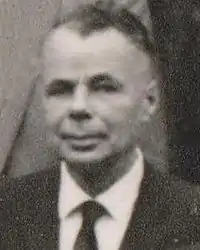Lothar Wolfgang Nordheim
Lothar[note 1] Wolfgang Nordheim (November 7, 1899, Munich – October 5, 1985, La Jolla, California) was a German born Jewish American theoretical physicist. He was a pioneer in the applications of quantum mechanics to solid-state problems, such as thermionic emission, work function of metals,[1] field electron emission, rectification in metal-semiconductor contacts and electrical resistance in metals and alloys.[2][3] He also worked in the mathematical foundations of quantum mechanics, cosmic rays and in nuclear physics.
Lothar Wolfgang Nordheim | |
|---|---|
 Lothar Nordheim, 1963 at Copenhagen | |
| Born | 7 November 1899 |
| Died | 10 October 1985 (aged 85) |
| Alma mater | University of Göttingen |
| Known for | Field electron emission: • Fowler–Nordheim-type equations • Fowler–Nordheim tunneling • Schottky–Nordheim barrier Quantum Boltzmann equation Fuchs-Nordheim method |
| Scientific career | |
| Fields | Statistical physics |
| Institutions | Duke University |
| Academic advisors | Max Born |
| Doctoral students | Walter Goad |
Life
He obtained his PhD in 1923, under the supervision of Max Born in the University of Göttingen.[2][3] He also worked with Edward Teller on the muon, sparkling his interest in cosmic rays.[3]
As a "physical assistant" to David Hilbert (like his teacher Born before him), he worked with him John von Neumann and Eugene Wigner on the mathematical formulation of quantum mechanics in 1928.[4]
He wrote extensive articles[5] for the Lehrbuch der Physik by J.H.J. Müller and Claude Pouillet on the quantum theory of magnetism and the conduction phenomena in metals.[2][3] During the same period was the holder of a Rockefeller Foundation Research Fellowship, a Lorentz Fellowship.[3] He lectured at Göttingen and was also a visiting professor at the University of Moscow.[2][3]
In the early 1930s he got interested in Fermi's theory of beta decay and worked with Hans Bethe on meson decay.[3]
Upon his immigration to the United States in 1934 Nordheim served as a visiting professor at Purdue University, working on cosmic rays, moving on to a permanent faculty position at Duke University in 1937.
He married German physicist Gertrud Pöschl in 1935, and together worked on structure and spectra of polyatomic molecules.[2]
During the World War II, he worked as a member of the Manhattan Project as head of department in the Clinton Laboratories in Oak Ridge and from 1945 to 1947 head of the physics department there.[2]
His wife died in accident during a stay in Germany in 1935, Nordheim was deeply affected.[3] He later decided to move to California. In 1956 he became a scientist at the John L. Hopkins Laboratory of Pure and Applied Science of General Atomics in San Diego and later chairman of the theoretical physics department.[2] There he mainly dealt with the physics of nuclear reactors and neutron physics.[2][3] In the early 1950s, however, he also made early contributions to the nuclear shell model with Maria Goeppert Mayer.[6][3]
He was elected in 1936 a Fellow of the American Physical Society.[7] In 1951 he received the honorary degree of Doctor in Science from the Karlsruhe Institute of Technology and 1963 from Purdue University.[3] He was also the first to give the Fritz London Memorial Lecture at Duke University in 1956.[3]
Field electron emission
An important contribution, with the British physicist Ralph H. Fowler in 1928,[8] was to establish the correct physical explanation of the physical phenomenon now called field electron emission. They established that electron emission occurred by a form of wave-mechanical tunneling, now called Fowler–Nordheim tunneling, and, with the help of the assumption that electrons in metals obeyed Fermi-Dirac statistics, derived an (approximate) emission equation. Over time, this equation has been developed into a family of approximate equations (offering different degrees of approximation to reality, when describing field emission from bulk metals), known as Fowler–Nordheim-type equations.
Fowler-Nordheim tunneling was the first effect in physics to be firmly identified as due to wave-mechanical tunneling, in the early days of quantum mechanics. The original Fowler-Nordheim-type equation was one of the first to use Fermi-Dirac statistics to explain an experimental phenomenon involving electrons in metals, and its success greatly helped to establish modern electron band theory.[9] The Fowler-Nordheim paper also established the physical basis for a unified treatment of field-induced and thermally induced electron emission.[9]
The ideas of J. Robert Oppenheimer, Fowler and Nordheim were also an important stimulus to the development, by George Gamow,[10] and Ronald W. Gurney and Edward Condon,[11][12] later in 1928, for the theory of the radioactive decay of nuclei (by alpha particle tunneling).[13]
References
- Nordheim, Lothar W. (1934). The theory of thermoelectric effects. Paris: Hermann.
- "Purdue University: Department of Physics and Astronomy: Lothar Wolfgang Nordheim". www.physics.purdue.edu. Retrieved 2021-07-14.
- "Lothar W. Nordheim | Department of Physics". physics.duke.edu. Retrieved 2021-07-14.
- van Hove, Léon (1958). "Von Neumann's contributions to quantum theory". Bull. Amer. Math. Soc. 64 (3): 95–99. doi:10.1090/s0002-9904-1958-10206-2. MR 0092587. Zbl 0080.00416.
- Nordheim, Lothar W. (1934). "Statistische und kinetische Theorie des metallischen Zustandes". Müller-Pouillets Lehrbuch der Physik. 4 (4): 243–389.
- Mayer, M. G.; Moszkowski, S. A.; Nordheim, L. W. (1951-10-01). "Nuclear Shell Structure and Beta-Decay. I. Odd A Nuclei". Reviews of Modern Physics. 23 (4): 315–321. Bibcode:1951RvMP...23..315M. doi:10.1103/RevModPhys.23.315. ISSN 0034-6861.
- "APS Fellow Archive". American Physical Society. (search on year=1936 and institution=Purdue University)
- Fowler, R.H.; Dr. L. Nordheim (1928-05-01). "Electron Emission in Intense Electric Fields" (PDF). Proceedings of the Royal Society A. 119 (781): 173–181. Bibcode:1928RSPSA.119..173F. doi:10.1098/rspa.1928.0091. Retrieved 2009-10-26.
- Sommerfeld, A.; Beth, H. (1963). "Handbuch der Physik". Julius Springer-Verlag. 24.
- Z. Physik 51, 204 (1928) G. Gamow, "Zur Quantentheorie des Atomkernes".
- Gurney, R.W.; Condon, E.U. (1928). "Wave mechanics and radioactive disintegration". Nature. 122 (3073): 439. Bibcode:1928Natur.122..439G. doi:10.1038/122439a0.
- Gurney, R.W.; Condon, E.U. (1929). "Quantum mechanics and radioactive disintegration". Physical Review. 33 (2): 127–140. Bibcode:1929PhRv...33..127G. doi:10.1103/PhysRev.33.127.
- Condon, E.U. (1978). "Tunneling – How It All Started". American Journal of Physics. 46 (4): 319–323. Bibcode:1978AmJPh..46..319C. doi:10.1119/1.11306.
Notes
- His name is sometimes misspelled as ''Lother''.